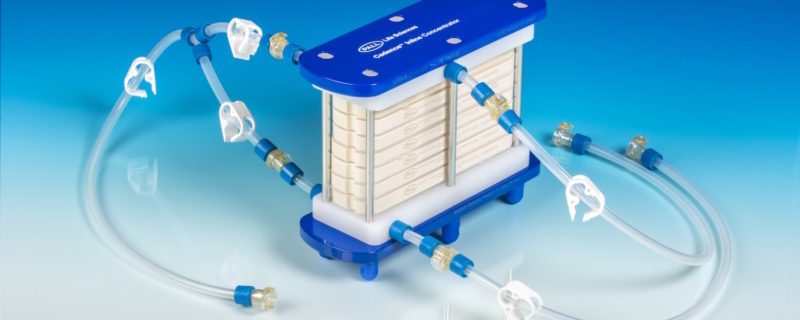
Optimize Downstream Processing with Single-Pass Inline Concentration
Concentration of biological drug substances is an important step at various stages in biomanufacturing. Concentration is often necessary between chromatography steps, in post harvest, during pre-capture or for in-process volume reduction. Concentration may also be needed between chromatography steps.
During concentration applications, there is a potential for aggregation, particularly with sensitive biologics even when they are only slightly stressed. Therefore, an effective concentration system must operate efficiently under mild conditions while at the same time being flexible enough to integrate readily with different downstream operations.
Advantages of single-pass tangential flow filtration (SPTFF) technology
Today, tangential-flow filtration (TFF) is the most widely used technique for the concentration of biologic drugs, but the technique can be challenging for shear-sensitive molecules because it involves recirculation of the process fluid. SPTFF provides a more attractive alternative. Eliminating the recirculation loop by using a unique flow path design and cassettes staged in a serial and parallel configuration, SPTFF is a viable option even for shear-sensitive proteins. Yields are also often higher because of improved product recovery and lower system working and hold-up volumes.
A ready-to-use solution is available
To make implementation of SPTFF simpler and more efficient, Pall Life Sciences launched the Cadence™ Inline Concentrator (ILC). The Cadence ILC was specifically designed to allow volume reduction before or after many different types of downstream processing steps. While it enables continuous processing by providing an easy to implement, plug and play design for coupling of different downstream processes, it can also be used as a stand-alone system.
Key benefits of the Cadence Inline Concentrator:
- High yield and productivity
- Easy integration
- Optimized processing of highly shear-sensitive products
The potential applications
Some of the potential applications of the Cadence ILC in addition to its use as an alternative to conventional TFF, include in-line volume reduction, concentration before capture, and concentration between different chromatographic purification steps. Different module sizes are available for use at all phases in the drug development cycle. For more information, the Genetic Engineering News Article, “Simplifying Bioprocessing with Single-Pass TFF,” provides details about applications leveraging SPTFF and the Cadence ILC.
Coupling SPTFF before loading onto a chromatography sorbent
Process and economic benefits could be achieved by coupling SPTFF and chromatography steps (i.e., before capture column or ion-exchange membrane chromatography) at manufacturing scale. This results in significant sorbent/buffer cost savings and/or reduced processing times. Additionally, the reduced volumes will also help to downsize all subsequent unit operations. As a result, smaller equipment, smaller tank sizes, and lower hold-up volumes will reduce system footprints. For more information, please see the application note, “Coupling Single-Pass TFF Before Loading Onto Chromatography Sorbent,” it summarizes the advantages of coupling SPTFF with chromatography.
SPTFF enables continuous bioprocessing
The Cadence ILC permits in-process concentration, which benefits continuous process applications such as perfusion culture methods. Concentration of bioprocess fluids with lower protein titer, such as those generated during perfusion, before multi-column or continuous chromatography enables significant process cost reduction. Continuous processing is also enabled by the easy integration of the Cadence ILC and its ability to couple a variety of processes for overall process integration.
